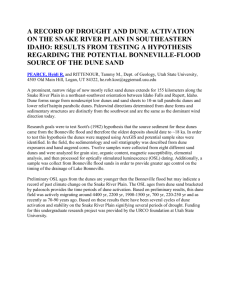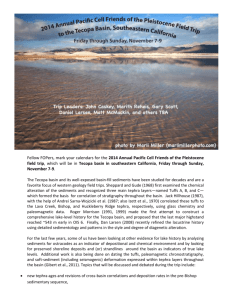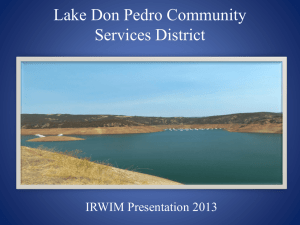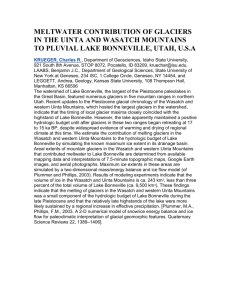DOC - GIS 4 Geomorphology
advertisement
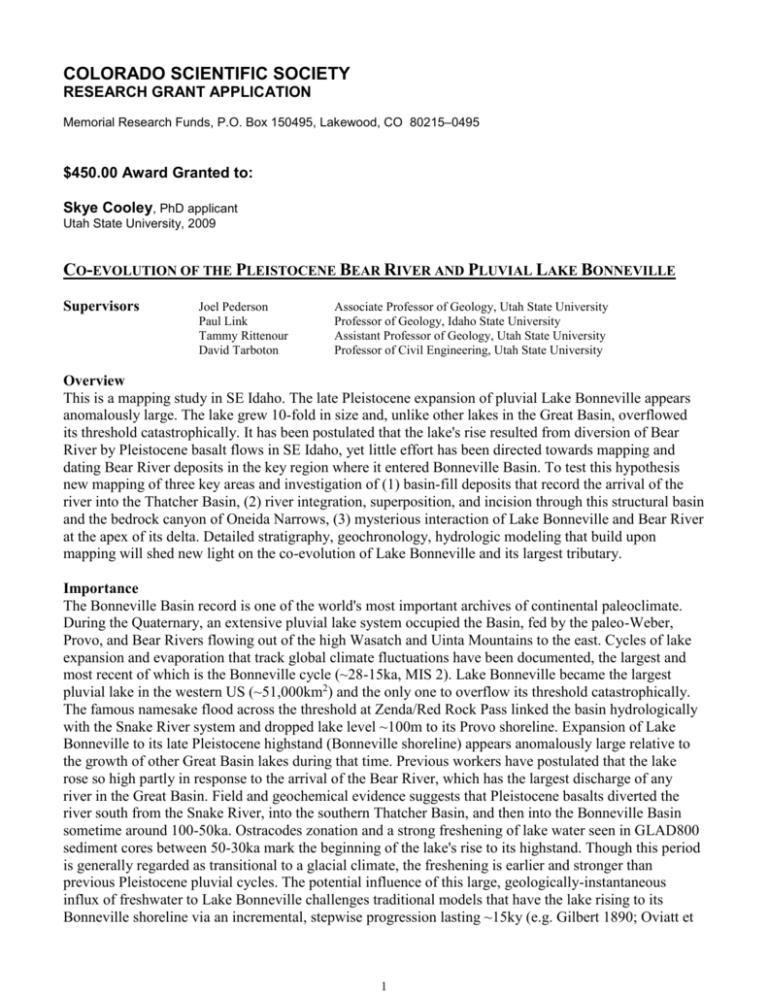
COLORADO SCIENTIFIC SOCIETY RESEARCH GRANT APPLICATION Memorial Research Funds, P.O. Box 150495, Lakewood, CO 80215–0495 $450.00 Award Granted to: Skye Cooley, PhD applicant Utah State University, 2009 CO-EVOLUTION OF THE PLEISTOCENE BEAR RIVER AND PLUVIAL LAKE BONNEVILLE Supervisors Joel Pederson Paul Link Tammy Rittenour David Tarboton Associate Professor of Geology, Utah State University Professor of Geology, Idaho State University Assistant Professor of Geology, Utah State University Professor of Civil Engineering, Utah State University Overview This is a mapping study in SE Idaho. The late Pleistocene expansion of pluvial Lake Bonneville appears anomalously large. The lake grew 10-fold in size and, unlike other lakes in the Great Basin, overflowed its threshold catastrophically. It has been postulated that the lake's rise resulted from diversion of Bear River by Pleistocene basalt flows in SE Idaho, yet little effort has been directed towards mapping and dating Bear River deposits in the key region where it entered Bonneville Basin. To test this hypothesis new mapping of three key areas and investigation of (1) basin-fill deposits that record the arrival of the river into the Thatcher Basin, (2) river integration, superposition, and incision through this structural basin and the bedrock canyon of Oneida Narrows, (3) mysterious interaction of Lake Bonneville and Bear River at the apex of its delta. Detailed stratigraphy, geochronology, hydrologic modeling that build upon mapping will shed new light on the co-evolution of Lake Bonneville and its largest tributary. Importance The Bonneville Basin record is one of the world's most important archives of continental paleoclimate. During the Quaternary, an extensive pluvial lake system occupied the Basin, fed by the paleo-Weber, Provo, and Bear Rivers flowing out of the high Wasatch and Uinta Mountains to the east. Cycles of lake expansion and evaporation that track global climate fluctuations have been documented, the largest and most recent of which is the Bonneville cycle (~28-15ka, MIS 2). Lake Bonneville became the largest pluvial lake in the western US (~51,000km2) and the only one to overflow its threshold catastrophically. The famous namesake flood across the threshold at Zenda/Red Rock Pass linked the basin hydrologically with the Snake River system and dropped lake level ~100m to its Provo shoreline. Expansion of Lake Bonneville to its late Pleistocene highstand (Bonneville shoreline) appears anomalously large relative to the growth of other Great Basin lakes during that time. Previous workers have postulated that the lake rose so high partly in response to the arrival of the Bear River, which has the largest discharge of any river in the Great Basin. Field and geochemical evidence suggests that Pleistocene basalts diverted the river south from the Snake River, into the southern Thatcher Basin, and then into the Bonneville Basin sometime around 100-50ka. Ostracodes zonation and a strong freshening of lake water seen in GLAD800 sediment cores between 50-30ka mark the beginning of the lake's rise to its highstand. Though this period is generally regarded as transitional to a glacial climate, the freshening is earlier and stronger than previous Pleistocene pluvial cycles. The potential influence of this large, geologically-instantaneous influx of freshwater to Lake Bonneville challenges traditional models that have the lake rising to its Bonneville shoreline via an incremental, stepwise progression lasting ~15ky (e.g. Gilbert 1890; Oviatt et 1 al. 1992). The arrival of the Bear River at some point in the late Pleistocene added ~1/3 more water to the lake, an addition that must have had a profound affect on the regional hydrological balance, from glacial headwaters to lake bottom. The hydrological impact of the Bear River on the Lake Bonneville system remains an uncontrolled variable that inhibits our understanding of this valuable record. Research Plan a.) New geologic mapping in a key corridor along the Bear River will establish links between the deeply incised Thatcher Basin and Bonneville Basin via Oneida Narrows. Numerous natural exposures, a dozen gravel pits, an extensive road system, and a sparsely-developed landscape afford clear views into the local stratigraphy. b.) New optically-stimulated luminescence (OSL) age control on previously unreported channel deposits of the late Pleistocene Bear River has already revised what is known about its post-incision history. We've established the only OSL dates for Bear River sediments in and earlier pilot study and are currently processing a new suite of samples. Previous research and hypotheses has suggested the excavation of valley fill in Thatcher Basin may have occurred in 30ky or less, which would make Oneida Narrows, obscure as it is, the location of perhaps some of the fastest incision rates in North America. c.) New 40Ar/39Ar dates on pillow basalts from flows believed responsible for diverting the Bear River to the south are being sought through other funding sources. Basalt flow fronts interfinger with sandy Pleistocene basin-fill sediments that have proven datable with OSL. d.) Long profiles of fluvial terraces above, within, and below Oneida Narrows will test whether a sediment-charged Bear River out-competed a rising Lake Bonneville at ~20ka (deposition of coarse material below the Narrows), or whether the river was choked back into the Narrows (forced to drop its coarse load above the Narrows). e.) A 2-D numerical hydrologic mass-balance model will explore the sensitivity of the overall watershed to the impact of the Bear River's abrupt arrival, as well as other variables. Forward modeling will explore Pleistocene climatic controls and interpretations of field findings by parameterized model scenarios. The work will build on previous hydrological and sediment mass-balance investigations. Bibliography Balch, D.P.; Cohen, A.S.; Schnurrenberger, D.W.; Haskell, B.J.; Valero Garces, B.L.; Beck, J.W.; Cheng, H.; Edwards, R.L., 2005, Ecosystem and paleohydrological response to Quaternary climate change in the Bonneville Basin, Utah, Palaeogeography, Palaeoclimatology, Palaeoecology, 221, p. 99-122 Benson, L.V.; Currey, D.R.; Dorn, R.I.; Lajoie, K.R.; Oviatt, C.G.; Robinson, S.W.; Smith, G.I.; Stine, S., 1990, Chronology of expansion and contraction of four great basin lake systems during the past 35,000 years, Palaeogeography, Palaeoclimatology, Palaeoecology, 78, p. 241-286 Bouchard D.P.; Kaufman D.S.; Hochberg, A.; Quade J., 1998, Quaternary history of the Thatcher Basin, Idaho, reconstructed from the 87Sr/86Sr and amino acid composition of lacustrine fossils: Implications for the diversion of the Bear River into the Bonneville Basin, Palaeogeography, Palaeoclimatology, Palaeoecology, 141, p. 95-114 Bright, R.C., 1963, Pleistocene Lakes Thatcher and Bonneville, southeastern Idaho, PhD Dissertation, University of Minnesota, 292 pgs. Gilbert, G.K., 1890, Lake Bonneville, United States Geological Survey Monograph, 1, 438 pgs. Link, P.K., Kaufman, D.S.; Thackray, G.D., 1999, Field guide to Pleistocene Lakes Thatcher and Bonneville and the Bonneville Flood, southeastern Idaho, in Hughes, S.S.; Thackray, G.D. (eds.), Guidebook to the Geology of Eastern Idaho, Idaho Museum of Natural History, p. 251-266 2 Malde, H.E., 1968, The catastrophic Late Pleistocene Bonneville Flood in the Snake River Plain, Idaho, USGS Professional Paper, 596, 73 pgs. O'Connor, J.E., 1993, Hydrology, hydraulics, and geomorphology of the Bonneville flood, GSA Special Paper, 274, p. 83 pgs. Oviatt, C.G.; Currey, D.R.; Sack, D., 1992, Radiocarbon chronology of Lake Bonneville, eastern Great Basin, USA, Palaeogeography, Palaeoclimatology, Palaeoecology, 99, p. 225-241 3


